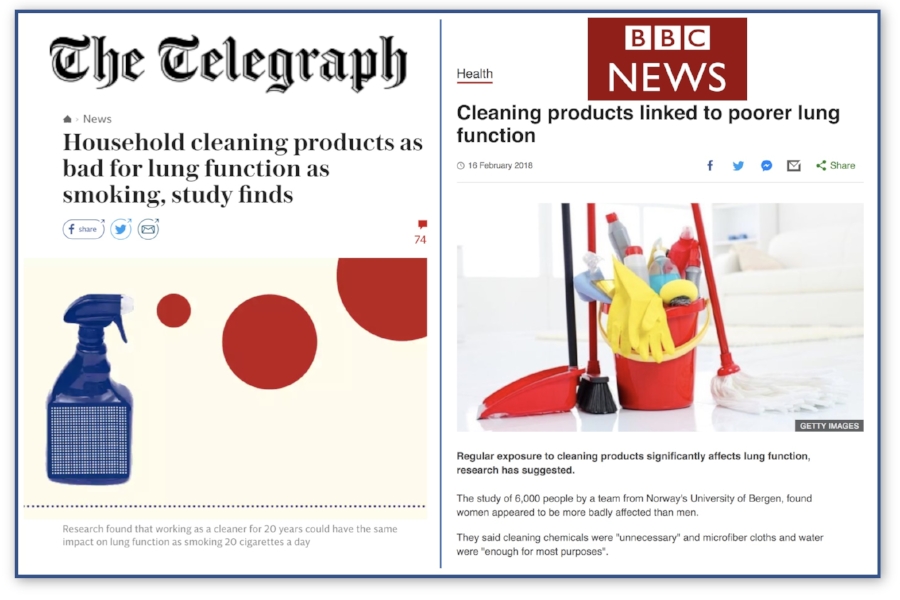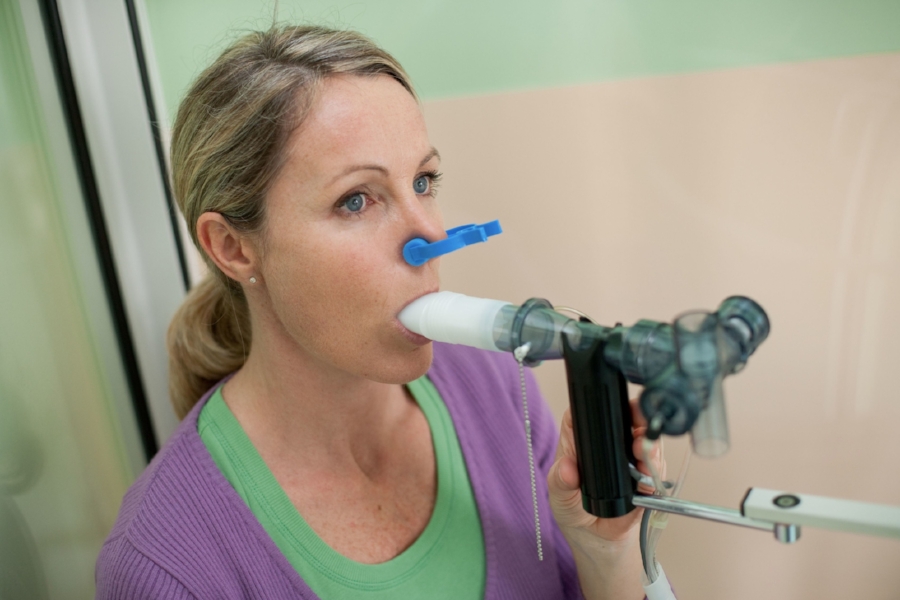Science Says Ditch Cleaners Now!
When I go grocery shopping, I always avoid the aisle stocked with cleaning products, not because I never buy anything from that section of the store, since I'm a Norwexer who cleans with microfiber and water, but for another reason altogether---off-gassing. Perfumed poison from those household cleaners seeps right through the plastic containers, like an invisible toxic cloud. The synthetic volatile organic compounds, disguised on the labels as "fragrances," burn my lungs, irritate my throat, and make my eyes water. In fact, even when the store is jammed with frantic shoppers during rush hour, I won't even take a shortcut down that aisle, because I don't want those endocrine disrupting molecules clinging to my clothes, sticking to my hair, fusing to my eyeballs, and coating the inside of my nose, mouth, throat.
Ok, some of you might be thinking, "Oh, Gayle, that's quite a rant. Calm down. It’s not a matter of life and death. Chill out, girlfriend." My response? "NO! IT IS A MATTER OF LIFE AND DEATH, and now we have the science to prove it."
SCIENCE NEWS FROM NORWAY
Let me introduce you to Professor Cecilie Svanes of the University of Bergen, in Norway. Click on this link to view her impressive credentials. Dr. Svanes has something important to say to us!
Dr. Cecilie Svanes is all over the news this week because her team of researchers, including PhD Candidate, Oistein Svanes, (pictured on the right), just published a ground-breaking study of lung damage caused by household cleaning products.
Their research project is titled, "Cleaning at Home and at Work in Relation to Lung Function Decline and Airway Obstruction." Click on this link to download the full text of their research. This longitudinal study has generated an avalanche of news stories all over the European press.
With all the controversy in America over "fake news," it is important to follow the money to ensure that the research is objective and unbiased. Here is the disclosure statement that accompanies this study…
"None of the study sponsors/funders had any role on study design, data collection, data analysis, data interpretation, or writing of this report. The corresponding authors had full access to all the data in the study, and had full responsibility for the decision to submit the study for publication"
Funding for this project came from the European Union's Horizon 2020 Program.Click on the link to see the source and purpose of the money that funded this research.
STUDY DATA AND METHODOLOGY
The data comes from 6,235 participants in the European Community Respiratory Health Survey collected over the last 20 years. Subjects took surveys about their use of cleaning products. Then, they inhaled deeply and blew into tubes connected to Spirometers, which precisely measure how much air is forcefully blown out of one's lungs for one second. This is called an FEV1 (Forced Expiratory Volume) measurement.
People with healthy lungs can blow out a lot of air, registering high FEV1 scores.
Conversely, people with damaged lungs blow out less air, thus registering low FEV1 scores.
After adjusting for age, gender, body mass index, smoking habits, location, education, income, and occupation, researchers looked for patterns in the data. Their conclusions were astonishing.
- Most cleaning agents, including ammonia and bleach, irritate the mucous membranes of the airways.
- Repetitive, long-term exposure to cleaning products causes inflammation of the lungs, which, in turn, leads to remodelling of the airways, causing an accelerated decline in lung function over time.
- Women not working as cleaners, and not involved in cleaning at home, showed the lowest decline in lung function.
- Female occupational cleaners, who also cleaned at home, had the highest decline in lung function.
- The lung damage found in women working as cleaners was comparable to the lung damage found in women who smoked 20 cigarettes every day over the same time period.
CONCLUSION: Women cleaning at home or working as occupational cleaners had accelerated decline in lung function, suggesting that exposures related to cleaning activities constitute a risk to long-term respiratory health.
According to Dr. Svanes, "The spray-head turns the chemicals into very small respirable units that can enter deeply into the lungs. Also, the smallest units in such a spray are the ones that linger in the air for hours."
Study co-author, Oistein Svanes, adds, "When you think of inhaling small particles from cleaning agents that are meant for cleaning the floor, and not your lungs, maybe it isn't so surprising after all. The take-home message is that in the long run cleaning chemicals cause rather substantial damage to your lungs. The chemicals are usually unnecessary; microfiber cloths and water are more than enough for most purposes."
Source: http://www.dailymail.co.uk/health/article-5397199/Cleaning-bad-womens-lungs-20-cigarettes-day.html
WHY WE USE NORWEX IN OUR HOME
Of course, as a Norwex consultant, I strongly recommend cleaning with microfiber and water, too. Our home is a "safe haven." We use safe and environmentally-friendly products from Norwex: Cleaning Paste to replace adhesive-removers, Peppermint Foaming Hand Soap to replace anti-bacterial soaps, Ultra Power Plus laundry detergent to replace fragrance laden store-bought brands, the Norwex EnviroCloth to replace disinfecting wipes, and the Norwex Window Cloth to replace spray glass cleaner and paper towels.
I know it's personal, anecdotal evidence, but no one in our household has asthma, rashes, or eczema. None of us have developed chronic conditions that commit us to taking prescription medications for years to come. We have found that eliminating chemicals in our home has improved our everyday quality of life.
And, we are especially excited about the new research and manufacturing center that Norwex is constructing in Coppell, Texas this year. This state-of-the-art facility was the subject of my previous blog, "We Took the Tour!" We can't wait for the debut of innovative products that are actually good for human beings!
CLEANING PRODUCTS THAT WON'T HURT OUR LUNGS
Consider subscribing to EWG. The Environmental Working Group is a terrific watchdog organization that alerts consumers about especially hazardous household contaminants. Check out their Guide to Healthy Cleaning. Click on this link. You can do your own research to find the cleaning agents that you want to use in your home. Thousands of products get rated on an A through F scale, which indicates their safety or toxicity.
WRAP UP MESSAGE
The University of Bergen study is a real eye-opener!
My heart goes out to the thousands of women who suffered lung damage over the last twenty years. Cleaning their own homes, and the homes of their clients, shouldn't have had such a negative impact on their lungs. Their experience at the hands of chemical companies is an abomination. I'm grateful that they courageously volunteered to participate in this landmark study---research that warns us away from the same fate.
I also feel indebted to Dr. Cecilie Svanes, Oisten Svanes, and the rest of the research team at Bergen University. The information they revealed this week is a great benefit to us all. Thank you for your patience, diligence, expertise, and scientific rigor.
We all want to live in clean, healthy homes, right? Sadly, chemical corporations advertise, and profit, from products that contain toxic ingredients that are often withheld from consumer product labels, and are also not tested for long-term impact on the health of people and pets.
There is an empowering solution to the current status quo, that is..."vote no" with our dollars. Refuse to purchase household chemicals and make the transition to the 21st century way to clean---with water and microfiber.
We must do our own research to find products that don't put our families at risk. Fortunately, the Environmental Working Group's Guide to Healthy Cleaning can help us find consumer products that create greater assurances about what ingredients are present in the bottles we buy. Likewise, the new Norwex Research and Manufacturing Institute will also bring Earth-friendly and family-friendly products to market in the coming months and years.
It gives me great hope that good people (brilliant researchers, responsible journalists, Norwex employees and Consultants, and the staff at EWG) are doing good things for consumers.
Hey, I'm breathing easier already, ...are you?












